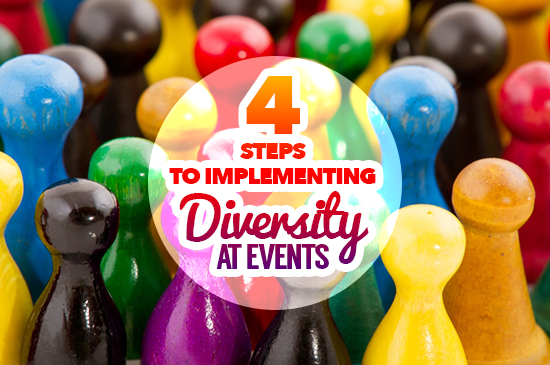This is a sponsored post written by Kristen Carvalho, Senior Content & Social Media Manager, etouches. More information about Event Manager Blog’s sponsored posts.
When planning your event do you think about every little need or accommodation that you attendees might need? From accessibility to food allergies to religious requirements and more, you need to make sure that you event is set up for success when it comes to diversity.


Diversity is a hot topic not only in the mainstream news, but in the events industry and even this blog! With Julius’ recent post on the lack of diversity on most panel or speaker line ups at events, it is clear that changes need to be made. We need to find ways to better represent our audience and accommodate all their needs. But working in an industry that is reluctant to change even the smallest tasks, how do we go about embracing diversity in our events?
We recently hosted a Google Hangout that tackled this tough issue not just in events but businesses as a whole. Talking with diversity experts from the hospitality, consulting and events industries we were able to define a framework for implementing diversity and inclusion in all business settings. With that, we came up with a diversity and inclusion check list for events to help planners make sure that they are properly organizing their events to meet everyone’s needs. We are going to touch on some of the biggest points to help you get your events set up for diversity success!
Start with Your Team
You need to look at who you are working with and make sure that they understand the importance of diversity for your event. This means putting in place a framework and a guide on what your team needs to know when it comes to diversity.
• Start to read metrics on diversity and inclusion. For example, there are more CEOs named John then there are female CEOs at large companies. Become educated on what is happening around you so that you can take the steps to change the norm. Don’t only read the metrics, but read the news and see the stories that are happening. Make sure that your team knows your stance on diversity and what they need to do to accommodate all.
• When assembling your team, try and have diversity of perspectives, backgrounds, personalities and genders. This makes sure that you have thought of everything when it comes to planning your event. Think about your own group of friends, you are not all alike because that would be boring. You have a difference of opinions and ideas that make you see things in a new light. Set up your event team like that.
Think About Event Logistics
Now that your team is organized you need to start getting your event in order. This means thinking of ways that you can add diversity into your event and thinking about certain scheduling conflicts when it comes to logistics.
• Whatever type of event you are hosting, whether it is pharmaceutical conference, technology summit or celebrity food event you need to keep your attendees in mind. When it comes to the date of your event, make sure that you steer clear of any major religious holidays and festivals. You don’t want to neglect some of your audience because your show falls on a sacred day for them. You would be losing an attendee and they would be losing out on valuable information from your event.
• Invite a diverse group of people to your event. If you are hosting a global event, don’t just send invitations to people in your local area. Do your research and find other countries that would have an interest in your event and start placing ads on big media sites in the area. Do whatever you can do get a large group of people at your event from varying backgrounds, cultures, abilities and more. This is good for not only your event, but your attendees because they are able to network and learn from people with different views from them.
• When thinking about your event agenda try and add some topics on diversity or inclusion. If you are hosting an event with a keynote speaker, considering inviting someone who is a diversity expert who can speak to the audience on the topic. If you have a large tradeshow, add a track on diversity and inclusion in events to encourage speakers to submit topics.
Get Questions Answered During Registration
If you want to make sure that you are meeting all the needs of your attendees, then ask them specific questions during registration. Registration should be simple for your attendees, but it should also be the place where they can put in any special requirements that they might need for specific reasons.
• If you are hosting a global event you need to think about the language barrier. Add a section into your registration form that asks people if they will need materials or interpretation in another language.
• This is also the place to find out of any dietary modifications that you attendees have. I would leave this question open ended because there are many different allergies, medical, personal and religious reasons that people cannot eat certain things.
You want to make sure that you are accommodating everyone.
• Is your website accessible for those who cannot see? Look for a registration provider that is 508 compliant if you know you will be hosting an event where you will have people who have disabilities.
Cover All Your Bases Onsite
When you are looking for your event venue it can be a daunting task without even thinking about all the considerations that you need to put in place to make your attendees feel welcomed. There are a few things to remember.
• If you are looking at a venue with multiple levels, is there an elevator available for wheelchair users or people with disabilities? You don’t want to alienate one of your attendees from the start.
• When thinking of cocktail hours or food options make sure you have some tables that are lower to the ground so that food is in reach for everyone.
• Find a venue with close, local transportation options. You want your venue to be easy to get to with multiple ways to do so. Also, consider having parking spaces clearly marked with an international symbol for accessibility.
• Part of great meeting design is the seating options that you have. It is also important to make these accessible. Offer seating with backs to consider their varying needs, preferences and comfort levels.
In Conclusion
Successfully adding diversity to your event is a big task at hand. While you don’t need to start all at once, you should consider implementing a few options above to get things started. Once it is part of your normal event planning routine, it will be easier to add more options down the road.
Remember, you are there to make your attendees happy and feel welcome.






